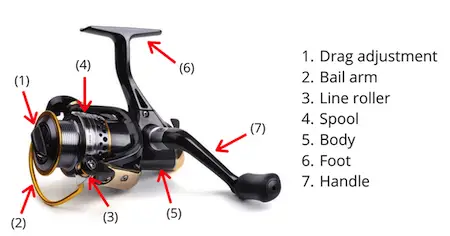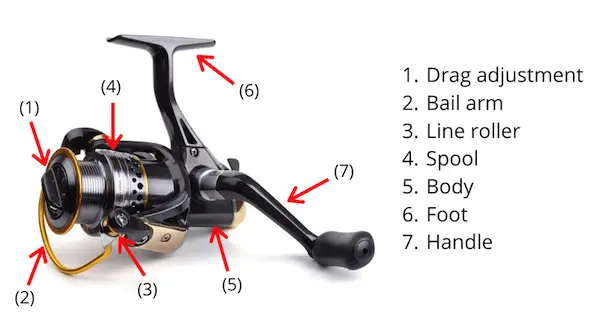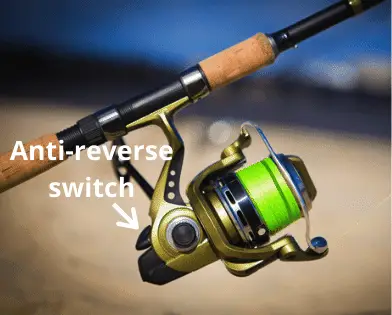Spinning Reel Parts & What To Look For When Buying A Reel
UPDATED 08 MAY 2023
by Robert Ceran
Choosing a spinning reel can be challenging, especially if you don’t understand how all the parts work of different types of fishing reels.
So, in order to buy the best spinning reel for the money, you need to understand the most important fishing reel parts, what they do, and what details you should be paying attention to.
If you learn how to choose a spinning reel based on understanding how its parts work, that will really improve your fishing experience, plus you’ll catch more fish.

We created this fishing reel guide to help you identify the key fishing reel parts, and to understand what to look for in the best spinning reel for your needs.
Most important parts of a spinning reel
- Foot
- Handle
- Spool
- Body
- Bail arm
- Drag adjustment knob
- Line roller
- Anti reverse switch
These are the most important fishing reel parts that you need to be aware of when you consider how to choose a fishing reel.
Spinning reel parts diagram:

Internal parts of a spinning reel
- Drag system
- Gear box
- Ball bearings
These are the most important internal parts of a fishing reel. Let’s take a closer look at the first two:
Fishing reel ball bearings explained
Ball bearings are an essential part of spinning reel design. They are located within the housing and reduce rotational friction, thereby providing stability during rotation.
This results in a smoother retrieval action of the reel. In addition, many reels also have a roller bearing placed in the line roller to further ensure smoothness of rotation.
Drag system explained
The drag system enables you to adjust pressure on the line spool, thereby modulating line pressure on a fish while battling it.
At the same time it allows a large fish to pull line off the spool whenever it makes a powerful run.
Without a strong and smooth drag system, letting out line during the battle could become a problem for your spinning reel – either the drag can get stuck, resulting in a broken line, or it can release line too easily, making it harder to set the hook when a fish grabs your lure.
Anti reverse switch on a spinning reel:

The anti reverse switch stops the handle from rotating backward, which allows the hook to be set with more power, thus increasing the chances of hooking a fish.
This is an essential feature to look for in a top quality reel.
What makes a good spinning reel?
A question we get all the time is, “what should I look for when buying a fishing reel?”
First of all, you’ll need to choose from a wide range of spinning reel sizes to pick the one that’s best for your purpose.
Once you’ve chosen the right reel size, you also need to understand the quality to look for in the fishing reel parts. Understanding this will also help you to maintain your spinning reel properly.
Here is an overview of what to look for in the most important fishing reel parts:
Material & weight
The housing of a spinning reel is usually built of aluminum or graphite, and in some cases both combined.
Aluminum is much harder than graphite, which makes it both heavier and more resistant to impact. On the other hand, graphite is a lot lighter.
For some applications, lightness is more important than strength. For long days of spin fishing for example, lightness definitely tends to win out over strength. Because of this, weight is a very important consideration when shopping for a reel.
If you shop online make sure you look at the reel weight, which is usually given in ounces, and if you shop in a tackle store, check reel weight by holding the reel in your hand.
Gear ratio
In contrast to baitcasting reels, which have a rotating spool when you turn the handle, spinning reels have a fixed spool, and the bail rotates around the spool while you turn the handle.
The gear ratio of a spinning reel indicates how many times the bail rotates around the spool in a single turn of the handle.
For instance, a 6:1 gear ratio on a spinning reel means that for every turn of the handle, the bail rotates six times around the spool.
What gear ratio should you look for?
A 4:1 ratio is considered slow speed, as only a short length of line is rolled onto the spool as you turn the handle once.
This can provide an advantage for battling large fish, as it provides more power. A 7:1 gear ratio, on the other hand, is much higher speed, which can be great for fast lure retrieval.
Your choice of ratio should be adapted to how you plan to use the fishing reel. In case you want a single reel to cover all your fishing needs, you may want to choose a 5:1 gear ratio, because of its medium speed.
If you are planning to get more than one spinning reel for different applications, choose both slow-speed and high-speed models to cover all your needs.
Ball bearings
Among the most important fishing reel parts are the ball bearings.
As a rule of thumb, the higher the number of ball bearings, the smoother the spinning reel will operate, though the price of the reel tends to go up as well.
We recommend looking for a reel with at least 4 or 5 ball bearings in order to ensure smooth action.
You don’t want a reel that performs jerky during line retrieval. Aim for as many ball bearings as you can afford for perfect performance.
Spool material
Spool design and material is also important for spinning reel performance. Just like reel bodies, spools are usually made of graphite or aluminum.
Again, aluminum spools are stronger and more rigid, while graphite is lighter. Also, spooling a spinning reel tends to be easier with an graphite spool, since the line doesn’t slide as much.
Another thing to keep in mind is if the spool is braid ready, which makes it easier to use with braided line (for more information on this topic, take a look at our article can you use braided line on a spinning reel).
Drag system
Since a poor quality drag system increases the chance of losing fish, this is a very important aspect you should check when purchasing a reel. The drag should be easy to adjust, and line should be let out smoothly without jerking.
Reel handle
Look for a reel with a relatively large knob that enables a stronger grip on the handle, which decreases slippage and improves grip control.
Also, keep in mind that a longer handle gives you more leverage when reeling in the line, compared to a short handle.
Conclusion
Deciding what is the best spinning reel can be quite a challenge when faced with all the options on the market nowadays.
Because of that it’s definitely helpful to know the basics of how the parts of a fishing reel work.
That way, you’ll know how to choose fishing reels of the highest quality.
Thinking of buying a new spinning reel? Make sure you check our reviews on the best spinning reel under $100.
And if you’re interested in finesse fishing, or other lightweight applications, have a look at the best ultralight spinning reels.
